Data Science Report: Megatrends, Competitive Forces, Internet Use
VerifiedAdded on 2021/06/17
|13
|3073
|75
Report
AI Summary
This report delves into several key areas within data science and information systems. It begins by exploring megatrends, examining the impact of Electronic Meeting Systems, Intranets, the evolving web, social media platforms, and wikis. The report then analyzes Porter's competitive forces, focusing on customer power and market entrants. Following this, it examines internet usage statistics, projecting future trends and discussing necessary changes to global network infrastructure. The report also covers social commerce, exploring how companies leverage customer networks and the organizational issues associated with social media. Furthermore, it touches upon database management systems, enterprise systems, and algorithm bias. The report provides detailed insights into each topic, making it a comprehensive overview of current trends and challenges in data science and related fields.

1
Name
Institution
Topic
Instructor
Name
Institution
Topic
Instructor
Paraphrase This Document
Need a fresh take? Get an instant paraphrase of this document with our AI Paraphraser
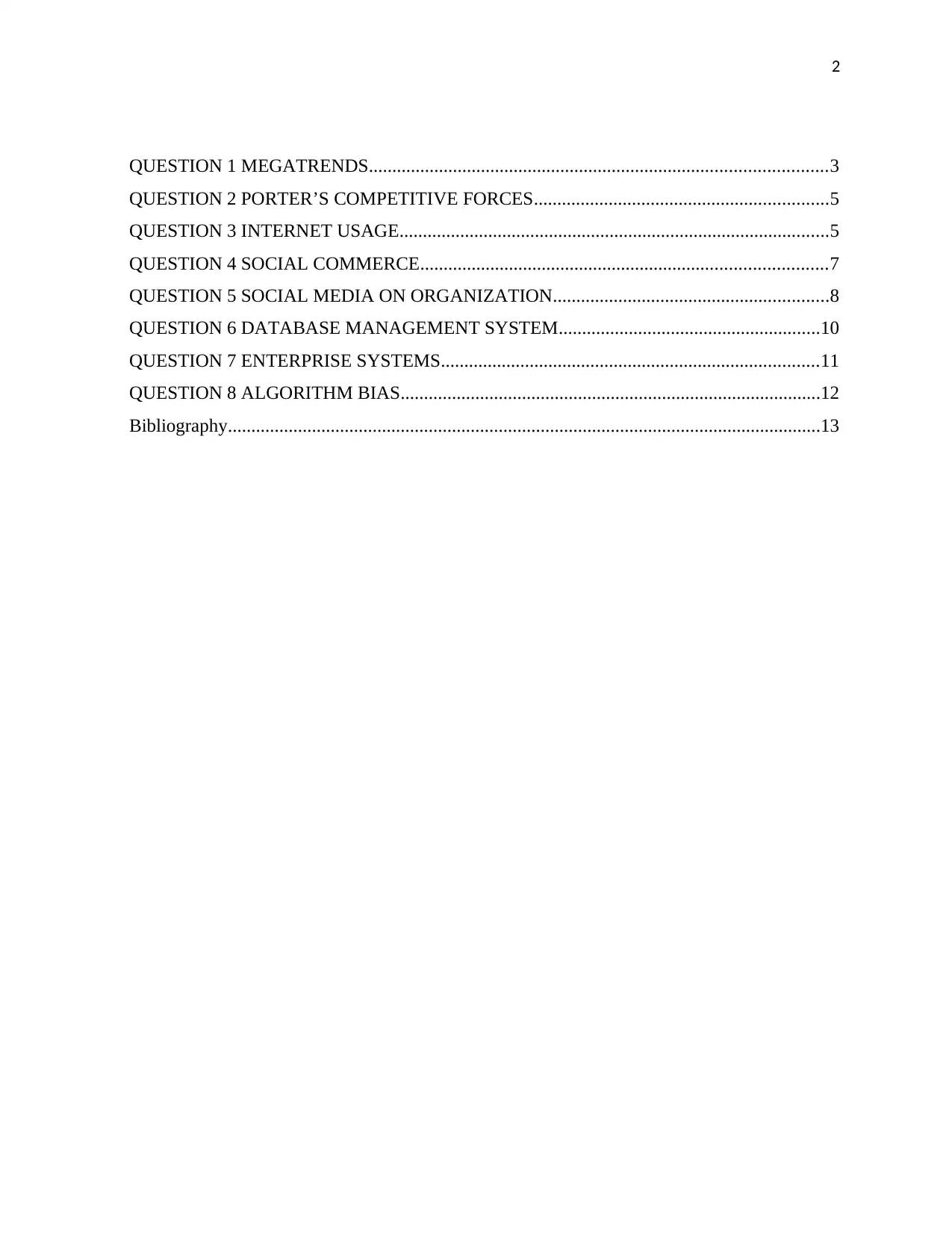
2
QUESTION 1 MEGATRENDS..................................................................................................3
QUESTION 2 PORTER’S COMPETITIVE FORCES...............................................................5
QUESTION 3 INTERNET USAGE............................................................................................5
QUESTION 4 SOCIAL COMMERCE.......................................................................................7
QUESTION 5 SOCIAL MEDIA ON ORGANIZATION...........................................................8
QUESTION 6 DATABASE MANAGEMENT SYSTEM........................................................10
QUESTION 7 ENTERPRISE SYSTEMS.................................................................................11
QUESTION 8 ALGORITHM BIAS..........................................................................................12
Bibliography...............................................................................................................................13
QUESTION 1 MEGATRENDS..................................................................................................3
QUESTION 2 PORTER’S COMPETITIVE FORCES...............................................................5
QUESTION 3 INTERNET USAGE............................................................................................5
QUESTION 4 SOCIAL COMMERCE.......................................................................................7
QUESTION 5 SOCIAL MEDIA ON ORGANIZATION...........................................................8
QUESTION 6 DATABASE MANAGEMENT SYSTEM........................................................10
QUESTION 7 ENTERPRISE SYSTEMS.................................................................................11
QUESTION 8 ALGORITHM BIAS..........................................................................................12
Bibliography...............................................................................................................................13
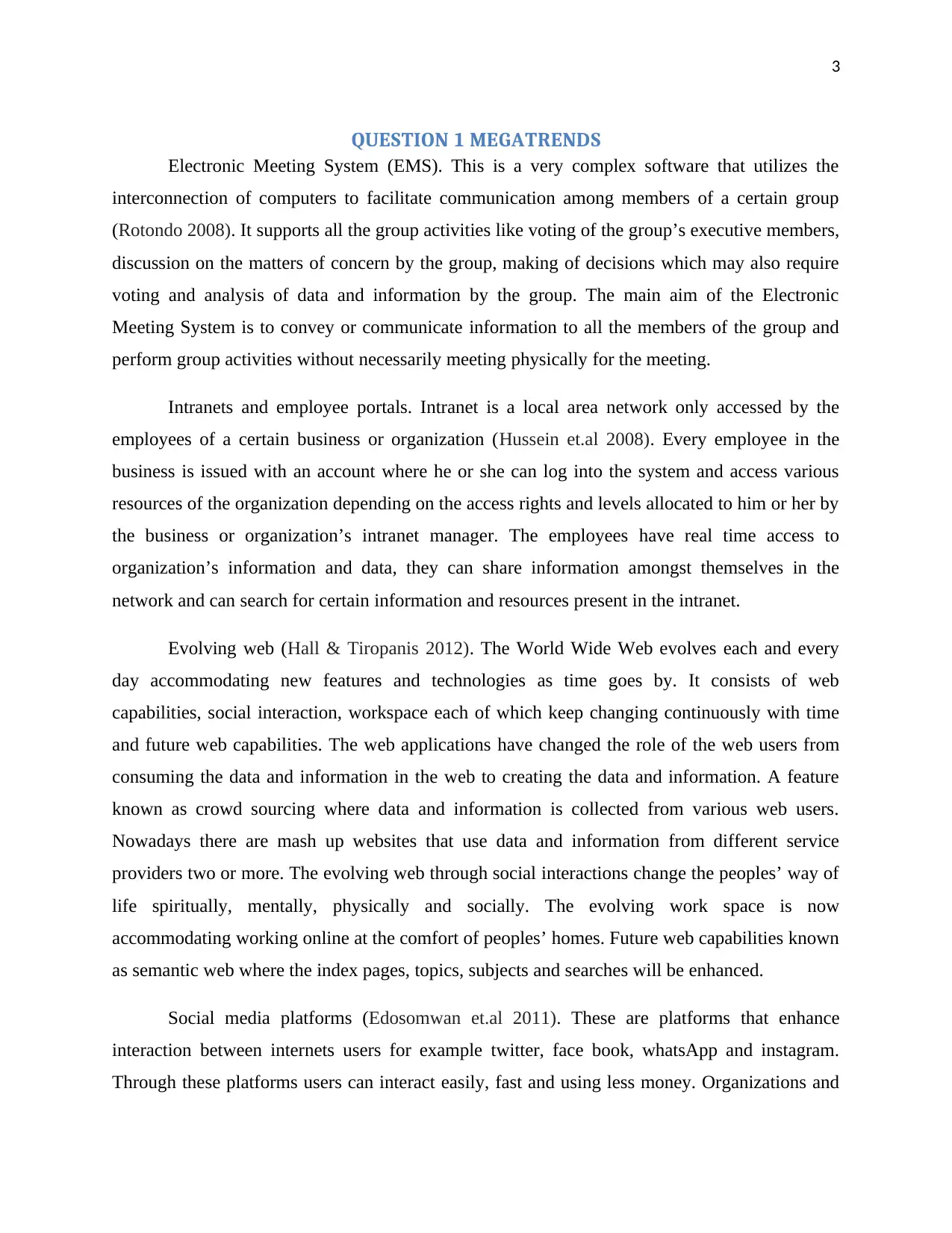
3
QUESTION 1 MEGATRENDS
Electronic Meeting System (EMS). This is a very complex software that utilizes the
interconnection of computers to facilitate communication among members of a certain group
(Rotondo 2008). It supports all the group activities like voting of the group’s executive members,
discussion on the matters of concern by the group, making of decisions which may also require
voting and analysis of data and information by the group. The main aim of the Electronic
Meeting System is to convey or communicate information to all the members of the group and
perform group activities without necessarily meeting physically for the meeting.
Intranets and employee portals. Intranet is a local area network only accessed by the
employees of a certain business or organization (Hussein et.al 2008). Every employee in the
business is issued with an account where he or she can log into the system and access various
resources of the organization depending on the access rights and levels allocated to him or her by
the business or organization’s intranet manager. The employees have real time access to
organization’s information and data, they can share information amongst themselves in the
network and can search for certain information and resources present in the intranet.
Evolving web (Hall & Tiropanis 2012). The World Wide Web evolves each and every
day accommodating new features and technologies as time goes by. It consists of web
capabilities, social interaction, workspace each of which keep changing continuously with time
and future web capabilities. The web applications have changed the role of the web users from
consuming the data and information in the web to creating the data and information. A feature
known as crowd sourcing where data and information is collected from various web users.
Nowadays there are mash up websites that use data and information from different service
providers two or more. The evolving web through social interactions change the peoples’ way of
life spiritually, mentally, physically and socially. The evolving work space is now
accommodating working online at the comfort of peoples’ homes. Future web capabilities known
as semantic web where the index pages, topics, subjects and searches will be enhanced.
Social media platforms (Edosomwan et.al 2011). These are platforms that enhance
interaction between internets users for example twitter, face book, whatsApp and instagram.
Through these platforms users can interact easily, fast and using less money. Organizations and
QUESTION 1 MEGATRENDS
Electronic Meeting System (EMS). This is a very complex software that utilizes the
interconnection of computers to facilitate communication among members of a certain group
(Rotondo 2008). It supports all the group activities like voting of the group’s executive members,
discussion on the matters of concern by the group, making of decisions which may also require
voting and analysis of data and information by the group. The main aim of the Electronic
Meeting System is to convey or communicate information to all the members of the group and
perform group activities without necessarily meeting physically for the meeting.
Intranets and employee portals. Intranet is a local area network only accessed by the
employees of a certain business or organization (Hussein et.al 2008). Every employee in the
business is issued with an account where he or she can log into the system and access various
resources of the organization depending on the access rights and levels allocated to him or her by
the business or organization’s intranet manager. The employees have real time access to
organization’s information and data, they can share information amongst themselves in the
network and can search for certain information and resources present in the intranet.
Evolving web (Hall & Tiropanis 2012). The World Wide Web evolves each and every
day accommodating new features and technologies as time goes by. It consists of web
capabilities, social interaction, workspace each of which keep changing continuously with time
and future web capabilities. The web applications have changed the role of the web users from
consuming the data and information in the web to creating the data and information. A feature
known as crowd sourcing where data and information is collected from various web users.
Nowadays there are mash up websites that use data and information from different service
providers two or more. The evolving web through social interactions change the peoples’ way of
life spiritually, mentally, physically and socially. The evolving work space is now
accommodating working online at the comfort of peoples’ homes. Future web capabilities known
as semantic web where the index pages, topics, subjects and searches will be enhanced.
Social media platforms (Edosomwan et.al 2011). These are platforms that enhance
interaction between internets users for example twitter, face book, whatsApp and instagram.
Through these platforms users can interact easily, fast and using less money. Organizations and
⊘ This is a preview!⊘
Do you want full access?
Subscribe today to unlock all pages.

Trusted by 1+ million students worldwide
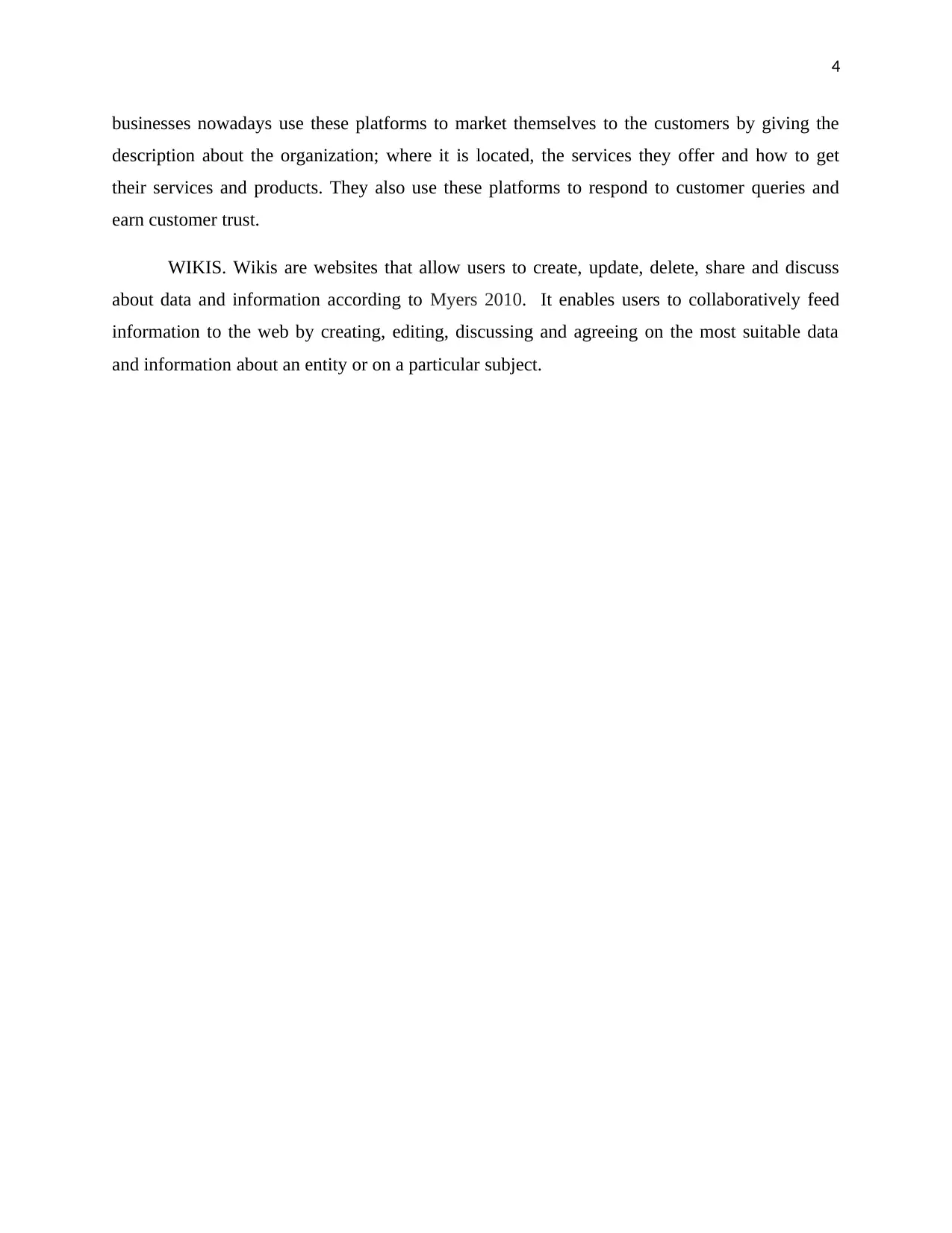
4
businesses nowadays use these platforms to market themselves to the customers by giving the
description about the organization; where it is located, the services they offer and how to get
their services and products. They also use these platforms to respond to customer queries and
earn customer trust.
WIKIS. Wikis are websites that allow users to create, update, delete, share and discuss
about data and information according to Myers 2010. It enables users to collaboratively feed
information to the web by creating, editing, discussing and agreeing on the most suitable data
and information about an entity or on a particular subject.
businesses nowadays use these platforms to market themselves to the customers by giving the
description about the organization; where it is located, the services they offer and how to get
their services and products. They also use these platforms to respond to customer queries and
earn customer trust.
WIKIS. Wikis are websites that allow users to create, update, delete, share and discuss
about data and information according to Myers 2010. It enables users to collaboratively feed
information to the web by creating, editing, discussing and agreeing on the most suitable data
and information about an entity or on a particular subject.
Paraphrase This Document
Need a fresh take? Get an instant paraphrase of this document with our AI Paraphraser
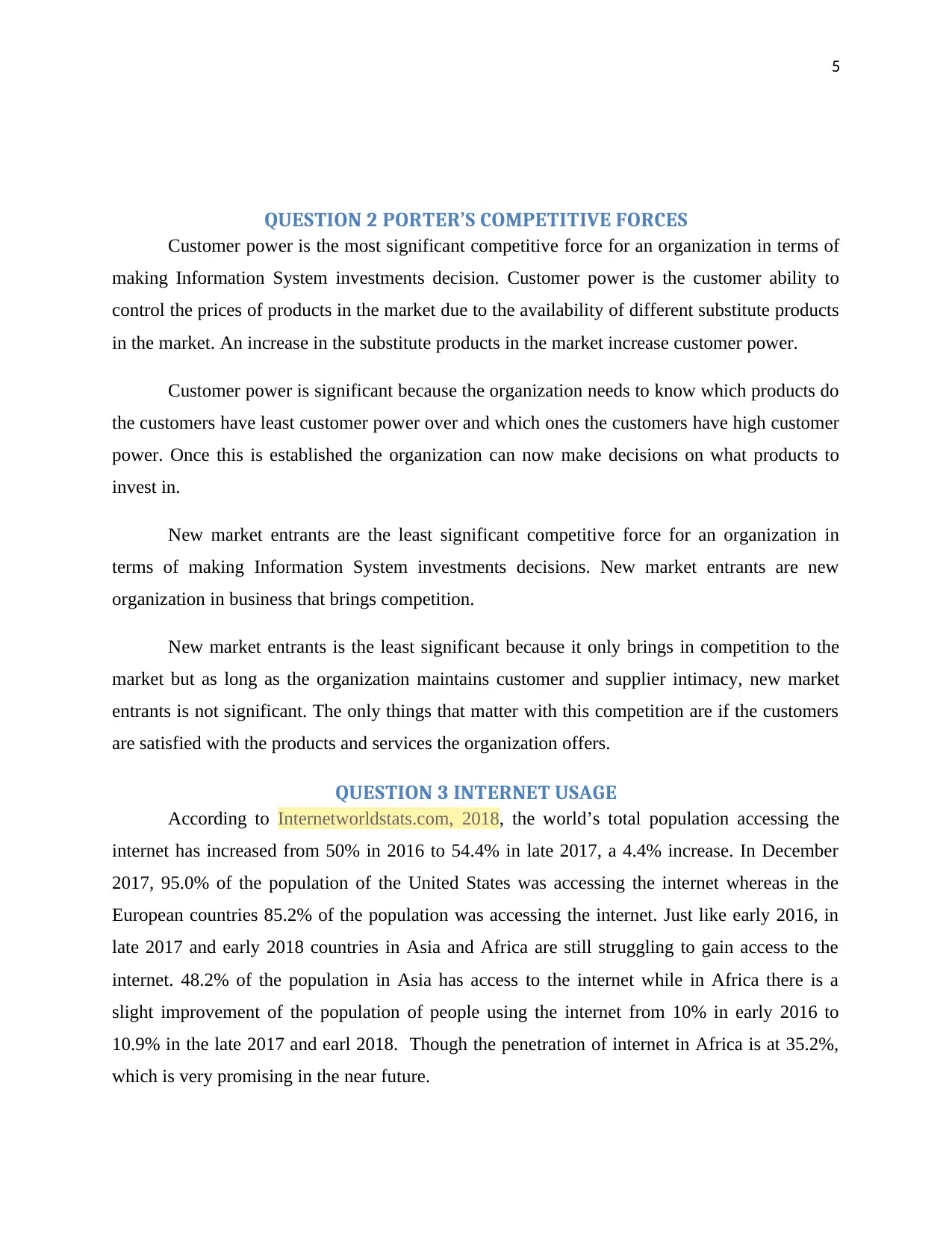
5
QUESTION 2 PORTER’S COMPETITIVE FORCES
Customer power is the most significant competitive force for an organization in terms of
making Information System investments decision. Customer power is the customer ability to
control the prices of products in the market due to the availability of different substitute products
in the market. An increase in the substitute products in the market increase customer power.
Customer power is significant because the organization needs to know which products do
the customers have least customer power over and which ones the customers have high customer
power. Once this is established the organization can now make decisions on what products to
invest in.
New market entrants are the least significant competitive force for an organization in
terms of making Information System investments decisions. New market entrants are new
organization in business that brings competition.
New market entrants is the least significant because it only brings in competition to the
market but as long as the organization maintains customer and supplier intimacy, new market
entrants is not significant. The only things that matter with this competition are if the customers
are satisfied with the products and services the organization offers.
QUESTION 3 INTERNET USAGE
According to Internetworldstats.com, 2018, the world’s total population accessing the
internet has increased from 50% in 2016 to 54.4% in late 2017, a 4.4% increase. In December
2017, 95.0% of the population of the United States was accessing the internet whereas in the
European countries 85.2% of the population was accessing the internet. Just like early 2016, in
late 2017 and early 2018 countries in Asia and Africa are still struggling to gain access to the
internet. 48.2% of the population in Asia has access to the internet while in Africa there is a
slight improvement of the population of people using the internet from 10% in early 2016 to
10.9% in the late 2017 and earl 2018. Though the penetration of internet in Africa is at 35.2%,
which is very promising in the near future.
QUESTION 2 PORTER’S COMPETITIVE FORCES
Customer power is the most significant competitive force for an organization in terms of
making Information System investments decision. Customer power is the customer ability to
control the prices of products in the market due to the availability of different substitute products
in the market. An increase in the substitute products in the market increase customer power.
Customer power is significant because the organization needs to know which products do
the customers have least customer power over and which ones the customers have high customer
power. Once this is established the organization can now make decisions on what products to
invest in.
New market entrants are the least significant competitive force for an organization in
terms of making Information System investments decisions. New market entrants are new
organization in business that brings competition.
New market entrants is the least significant because it only brings in competition to the
market but as long as the organization maintains customer and supplier intimacy, new market
entrants is not significant. The only things that matter with this competition are if the customers
are satisfied with the products and services the organization offers.
QUESTION 3 INTERNET USAGE
According to Internetworldstats.com, 2018, the world’s total population accessing the
internet has increased from 50% in 2016 to 54.4% in late 2017, a 4.4% increase. In December
2017, 95.0% of the population of the United States was accessing the internet whereas in the
European countries 85.2% of the population was accessing the internet. Just like early 2016, in
late 2017 and early 2018 countries in Asia and Africa are still struggling to gain access to the
internet. 48.2% of the population in Asia has access to the internet while in Africa there is a
slight improvement of the population of people using the internet from 10% in early 2016 to
10.9% in the late 2017 and earl 2018. Though the penetration of internet in Africa is at 35.2%,
which is very promising in the near future.
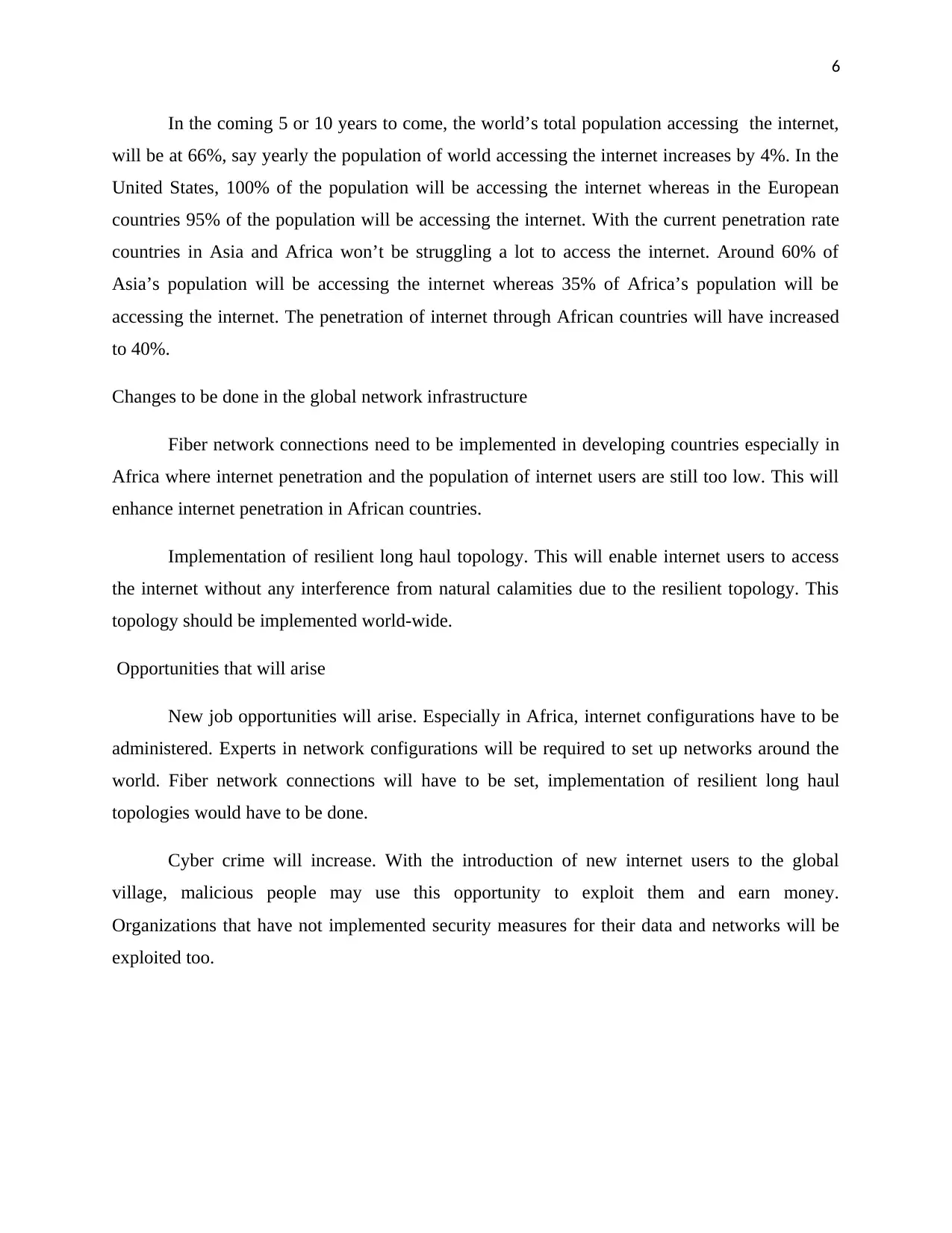
6
In the coming 5 or 10 years to come, the world’s total population accessing the internet,
will be at 66%, say yearly the population of world accessing the internet increases by 4%. In the
United States, 100% of the population will be accessing the internet whereas in the European
countries 95% of the population will be accessing the internet. With the current penetration rate
countries in Asia and Africa won’t be struggling a lot to access the internet. Around 60% of
Asia’s population will be accessing the internet whereas 35% of Africa’s population will be
accessing the internet. The penetration of internet through African countries will have increased
to 40%.
Changes to be done in the global network infrastructure
Fiber network connections need to be implemented in developing countries especially in
Africa where internet penetration and the population of internet users are still too low. This will
enhance internet penetration in African countries.
Implementation of resilient long haul topology. This will enable internet users to access
the internet without any interference from natural calamities due to the resilient topology. This
topology should be implemented world-wide.
Opportunities that will arise
New job opportunities will arise. Especially in Africa, internet configurations have to be
administered. Experts in network configurations will be required to set up networks around the
world. Fiber network connections will have to be set, implementation of resilient long haul
topologies would have to be done.
Cyber crime will increase. With the introduction of new internet users to the global
village, malicious people may use this opportunity to exploit them and earn money.
Organizations that have not implemented security measures for their data and networks will be
exploited too.
In the coming 5 or 10 years to come, the world’s total population accessing the internet,
will be at 66%, say yearly the population of world accessing the internet increases by 4%. In the
United States, 100% of the population will be accessing the internet whereas in the European
countries 95% of the population will be accessing the internet. With the current penetration rate
countries in Asia and Africa won’t be struggling a lot to access the internet. Around 60% of
Asia’s population will be accessing the internet whereas 35% of Africa’s population will be
accessing the internet. The penetration of internet through African countries will have increased
to 40%.
Changes to be done in the global network infrastructure
Fiber network connections need to be implemented in developing countries especially in
Africa where internet penetration and the population of internet users are still too low. This will
enhance internet penetration in African countries.
Implementation of resilient long haul topology. This will enable internet users to access
the internet without any interference from natural calamities due to the resilient topology. This
topology should be implemented world-wide.
Opportunities that will arise
New job opportunities will arise. Especially in Africa, internet configurations have to be
administered. Experts in network configurations will be required to set up networks around the
world. Fiber network connections will have to be set, implementation of resilient long haul
topologies would have to be done.
Cyber crime will increase. With the introduction of new internet users to the global
village, malicious people may use this opportunity to exploit them and earn money.
Organizations that have not implemented security measures for their data and networks will be
exploited too.
⊘ This is a preview!⊘
Do you want full access?
Subscribe today to unlock all pages.

Trusted by 1+ million students worldwide
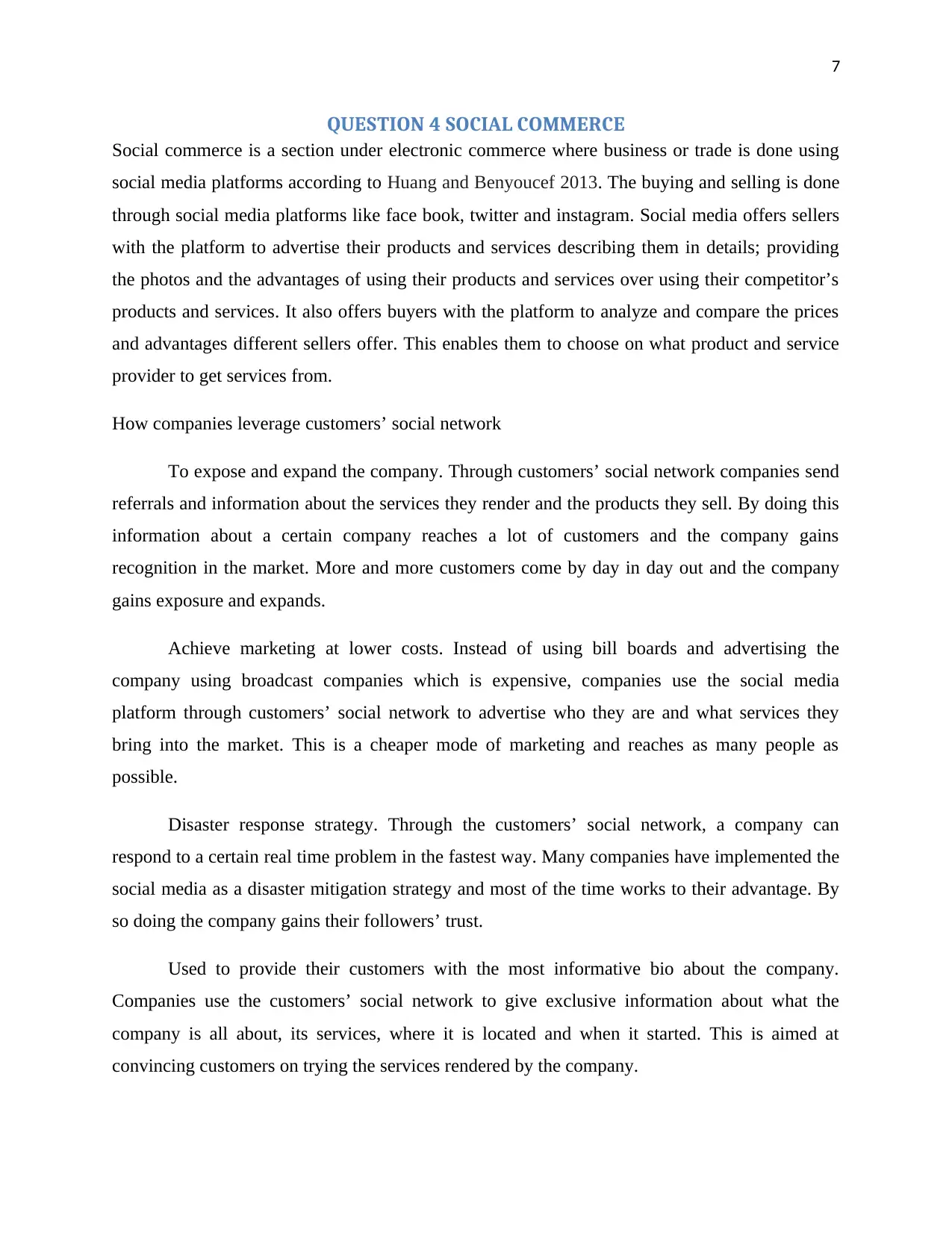
7
QUESTION 4 SOCIAL COMMERCE
Social commerce is a section under electronic commerce where business or trade is done using
social media platforms according to Huang and Benyoucef 2013. The buying and selling is done
through social media platforms like face book, twitter and instagram. Social media offers sellers
with the platform to advertise their products and services describing them in details; providing
the photos and the advantages of using their products and services over using their competitor’s
products and services. It also offers buyers with the platform to analyze and compare the prices
and advantages different sellers offer. This enables them to choose on what product and service
provider to get services from.
How companies leverage customers’ social network
To expose and expand the company. Through customers’ social network companies send
referrals and information about the services they render and the products they sell. By doing this
information about a certain company reaches a lot of customers and the company gains
recognition in the market. More and more customers come by day in day out and the company
gains exposure and expands.
Achieve marketing at lower costs. Instead of using bill boards and advertising the
company using broadcast companies which is expensive, companies use the social media
platform through customers’ social network to advertise who they are and what services they
bring into the market. This is a cheaper mode of marketing and reaches as many people as
possible.
Disaster response strategy. Through the customers’ social network, a company can
respond to a certain real time problem in the fastest way. Many companies have implemented the
social media as a disaster mitigation strategy and most of the time works to their advantage. By
so doing the company gains their followers’ trust.
Used to provide their customers with the most informative bio about the company.
Companies use the customers’ social network to give exclusive information about what the
company is all about, its services, where it is located and when it started. This is aimed at
convincing customers on trying the services rendered by the company.
QUESTION 4 SOCIAL COMMERCE
Social commerce is a section under electronic commerce where business or trade is done using
social media platforms according to Huang and Benyoucef 2013. The buying and selling is done
through social media platforms like face book, twitter and instagram. Social media offers sellers
with the platform to advertise their products and services describing them in details; providing
the photos and the advantages of using their products and services over using their competitor’s
products and services. It also offers buyers with the platform to analyze and compare the prices
and advantages different sellers offer. This enables them to choose on what product and service
provider to get services from.
How companies leverage customers’ social network
To expose and expand the company. Through customers’ social network companies send
referrals and information about the services they render and the products they sell. By doing this
information about a certain company reaches a lot of customers and the company gains
recognition in the market. More and more customers come by day in day out and the company
gains exposure and expands.
Achieve marketing at lower costs. Instead of using bill boards and advertising the
company using broadcast companies which is expensive, companies use the social media
platform through customers’ social network to advertise who they are and what services they
bring into the market. This is a cheaper mode of marketing and reaches as many people as
possible.
Disaster response strategy. Through the customers’ social network, a company can
respond to a certain real time problem in the fastest way. Many companies have implemented the
social media as a disaster mitigation strategy and most of the time works to their advantage. By
so doing the company gains their followers’ trust.
Used to provide their customers with the most informative bio about the company.
Companies use the customers’ social network to give exclusive information about what the
company is all about, its services, where it is located and when it started. This is aimed at
convincing customers on trying the services rendered by the company.
Paraphrase This Document
Need a fresh take? Get an instant paraphrase of this document with our AI Paraphraser
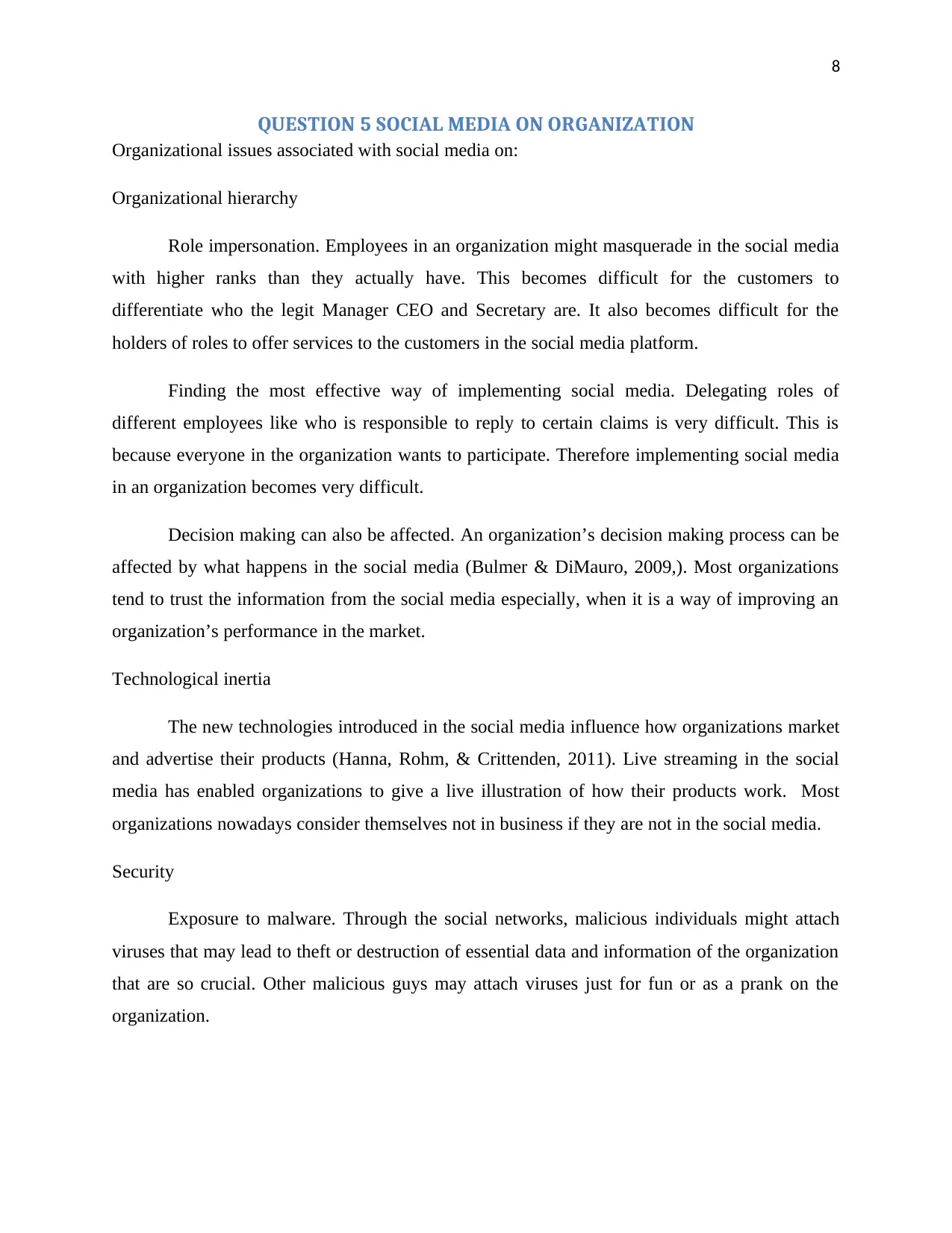
8
QUESTION 5 SOCIAL MEDIA ON ORGANIZATION
Organizational issues associated with social media on:
Organizational hierarchy
Role impersonation. Employees in an organization might masquerade in the social media
with higher ranks than they actually have. This becomes difficult for the customers to
differentiate who the legit Manager CEO and Secretary are. It also becomes difficult for the
holders of roles to offer services to the customers in the social media platform.
Finding the most effective way of implementing social media. Delegating roles of
different employees like who is responsible to reply to certain claims is very difficult. This is
because everyone in the organization wants to participate. Therefore implementing social media
in an organization becomes very difficult.
Decision making can also be affected. An organization’s decision making process can be
affected by what happens in the social media (Bulmer & DiMauro, 2009,). Most organizations
tend to trust the information from the social media especially, when it is a way of improving an
organization’s performance in the market.
Technological inertia
The new technologies introduced in the social media influence how organizations market
and advertise their products (Hanna, Rohm, & Crittenden, 2011). Live streaming in the social
media has enabled organizations to give a live illustration of how their products work. Most
organizations nowadays consider themselves not in business if they are not in the social media.
Security
Exposure to malware. Through the social networks, malicious individuals might attach
viruses that may lead to theft or destruction of essential data and information of the organization
that are so crucial. Other malicious guys may attach viruses just for fun or as a prank on the
organization.
QUESTION 5 SOCIAL MEDIA ON ORGANIZATION
Organizational issues associated with social media on:
Organizational hierarchy
Role impersonation. Employees in an organization might masquerade in the social media
with higher ranks than they actually have. This becomes difficult for the customers to
differentiate who the legit Manager CEO and Secretary are. It also becomes difficult for the
holders of roles to offer services to the customers in the social media platform.
Finding the most effective way of implementing social media. Delegating roles of
different employees like who is responsible to reply to certain claims is very difficult. This is
because everyone in the organization wants to participate. Therefore implementing social media
in an organization becomes very difficult.
Decision making can also be affected. An organization’s decision making process can be
affected by what happens in the social media (Bulmer & DiMauro, 2009,). Most organizations
tend to trust the information from the social media especially, when it is a way of improving an
organization’s performance in the market.
Technological inertia
The new technologies introduced in the social media influence how organizations market
and advertise their products (Hanna, Rohm, & Crittenden, 2011). Live streaming in the social
media has enabled organizations to give a live illustration of how their products work. Most
organizations nowadays consider themselves not in business if they are not in the social media.
Security
Exposure to malware. Through the social networks, malicious individuals might attach
viruses that may lead to theft or destruction of essential data and information of the organization
that are so crucial. Other malicious guys may attach viruses just for fun or as a prank on the
organization.
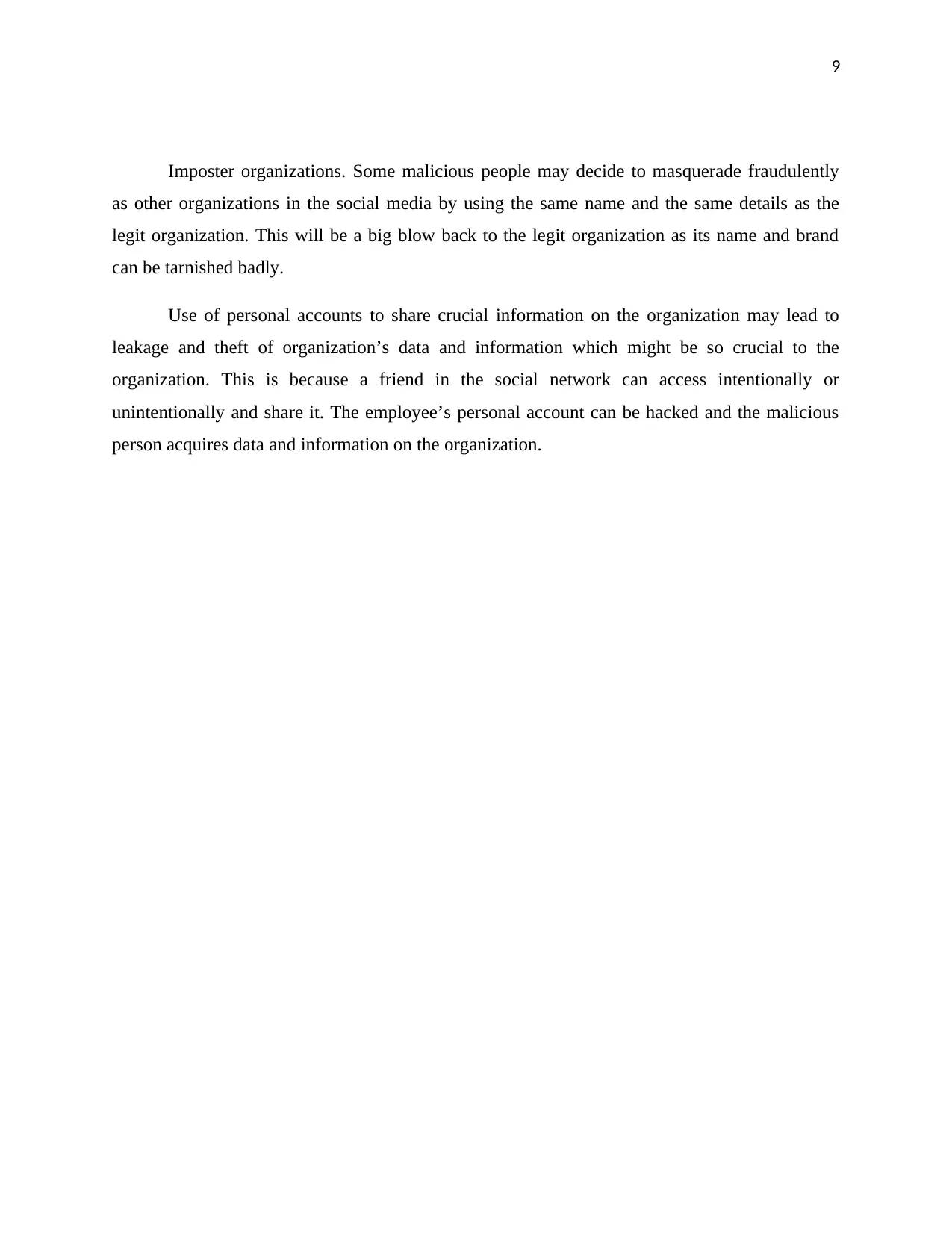
9
Imposter organizations. Some malicious people may decide to masquerade fraudulently
as other organizations in the social media by using the same name and the same details as the
legit organization. This will be a big blow back to the legit organization as its name and brand
can be tarnished badly.
Use of personal accounts to share crucial information on the organization may lead to
leakage and theft of organization’s data and information which might be so crucial to the
organization. This is because a friend in the social network can access intentionally or
unintentionally and share it. The employee’s personal account can be hacked and the malicious
person acquires data and information on the organization.
Imposter organizations. Some malicious people may decide to masquerade fraudulently
as other organizations in the social media by using the same name and the same details as the
legit organization. This will be a big blow back to the legit organization as its name and brand
can be tarnished badly.
Use of personal accounts to share crucial information on the organization may lead to
leakage and theft of organization’s data and information which might be so crucial to the
organization. This is because a friend in the social network can access intentionally or
unintentionally and share it. The employee’s personal account can be hacked and the malicious
person acquires data and information on the organization.
⊘ This is a preview!⊘
Do you want full access?
Subscribe today to unlock all pages.

Trusted by 1+ million students worldwide
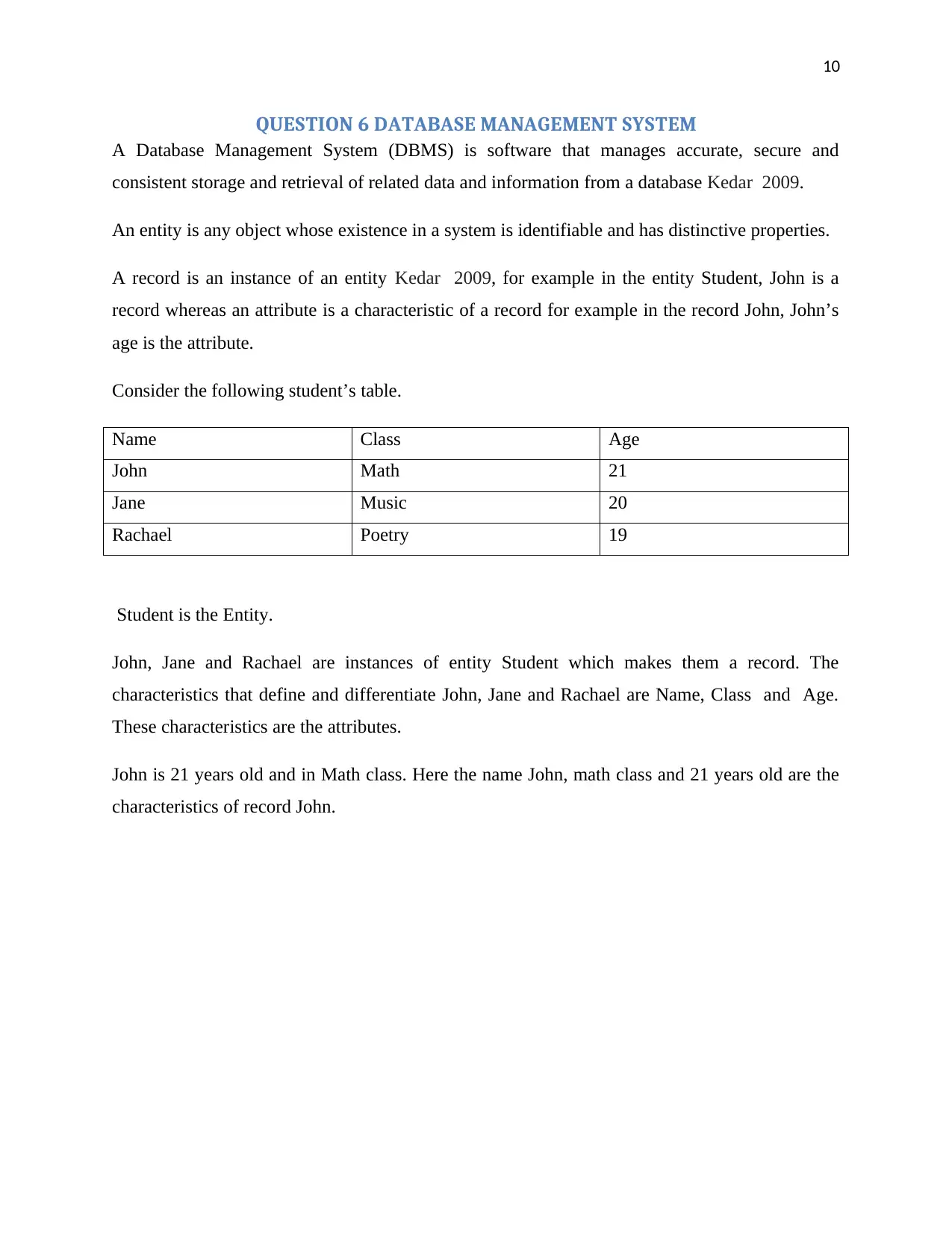
10
QUESTION 6 DATABASE MANAGEMENT SYSTEM
A Database Management System (DBMS) is software that manages accurate, secure and
consistent storage and retrieval of related data and information from a database Kedar 2009.
An entity is any object whose existence in a system is identifiable and has distinctive properties.
A record is an instance of an entity Kedar 2009, for example in the entity Student, John is a
record whereas an attribute is a characteristic of a record for example in the record John, John’s
age is the attribute.
Consider the following student’s table.
Name Class Age
John Math 21
Jane Music 20
Rachael Poetry 19
Student is the Entity.
John, Jane and Rachael are instances of entity Student which makes them a record. The
characteristics that define and differentiate John, Jane and Rachael are Name, Class and Age.
These characteristics are the attributes.
John is 21 years old and in Math class. Here the name John, math class and 21 years old are the
characteristics of record John.
QUESTION 6 DATABASE MANAGEMENT SYSTEM
A Database Management System (DBMS) is software that manages accurate, secure and
consistent storage and retrieval of related data and information from a database Kedar 2009.
An entity is any object whose existence in a system is identifiable and has distinctive properties.
A record is an instance of an entity Kedar 2009, for example in the entity Student, John is a
record whereas an attribute is a characteristic of a record for example in the record John, John’s
age is the attribute.
Consider the following student’s table.
Name Class Age
John Math 21
Jane Music 20
Rachael Poetry 19
Student is the Entity.
John, Jane and Rachael are instances of entity Student which makes them a record. The
characteristics that define and differentiate John, Jane and Rachael are Name, Class and Age.
These characteristics are the attributes.
John is 21 years old and in Math class. Here the name John, math class and 21 years old are the
characteristics of record John.
Paraphrase This Document
Need a fresh take? Get an instant paraphrase of this document with our AI Paraphraser
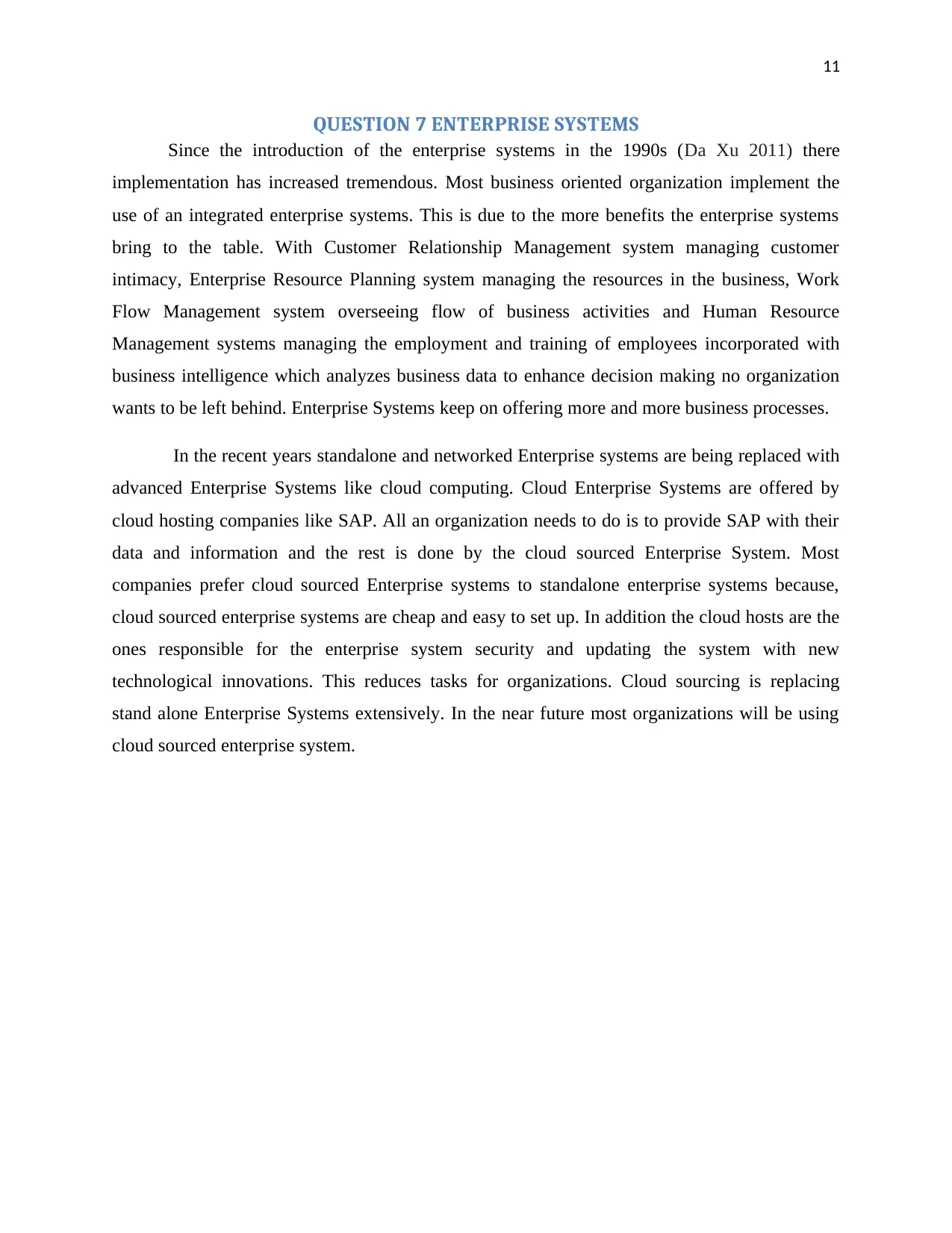
11
QUESTION 7 ENTERPRISE SYSTEMS
Since the introduction of the enterprise systems in the 1990s (Da Xu 2011) there
implementation has increased tremendous. Most business oriented organization implement the
use of an integrated enterprise systems. This is due to the more benefits the enterprise systems
bring to the table. With Customer Relationship Management system managing customer
intimacy, Enterprise Resource Planning system managing the resources in the business, Work
Flow Management system overseeing flow of business activities and Human Resource
Management systems managing the employment and training of employees incorporated with
business intelligence which analyzes business data to enhance decision making no organization
wants to be left behind. Enterprise Systems keep on offering more and more business processes.
In the recent years standalone and networked Enterprise systems are being replaced with
advanced Enterprise Systems like cloud computing. Cloud Enterprise Systems are offered by
cloud hosting companies like SAP. All an organization needs to do is to provide SAP with their
data and information and the rest is done by the cloud sourced Enterprise System. Most
companies prefer cloud sourced Enterprise systems to standalone enterprise systems because,
cloud sourced enterprise systems are cheap and easy to set up. In addition the cloud hosts are the
ones responsible for the enterprise system security and updating the system with new
technological innovations. This reduces tasks for organizations. Cloud sourcing is replacing
stand alone Enterprise Systems extensively. In the near future most organizations will be using
cloud sourced enterprise system.
QUESTION 7 ENTERPRISE SYSTEMS
Since the introduction of the enterprise systems in the 1990s (Da Xu 2011) there
implementation has increased tremendous. Most business oriented organization implement the
use of an integrated enterprise systems. This is due to the more benefits the enterprise systems
bring to the table. With Customer Relationship Management system managing customer
intimacy, Enterprise Resource Planning system managing the resources in the business, Work
Flow Management system overseeing flow of business activities and Human Resource
Management systems managing the employment and training of employees incorporated with
business intelligence which analyzes business data to enhance decision making no organization
wants to be left behind. Enterprise Systems keep on offering more and more business processes.
In the recent years standalone and networked Enterprise systems are being replaced with
advanced Enterprise Systems like cloud computing. Cloud Enterprise Systems are offered by
cloud hosting companies like SAP. All an organization needs to do is to provide SAP with their
data and information and the rest is done by the cloud sourced Enterprise System. Most
companies prefer cloud sourced Enterprise systems to standalone enterprise systems because,
cloud sourced enterprise systems are cheap and easy to set up. In addition the cloud hosts are the
ones responsible for the enterprise system security and updating the system with new
technological innovations. This reduces tasks for organizations. Cloud sourcing is replacing
stand alone Enterprise Systems extensively. In the near future most organizations will be using
cloud sourced enterprise system.
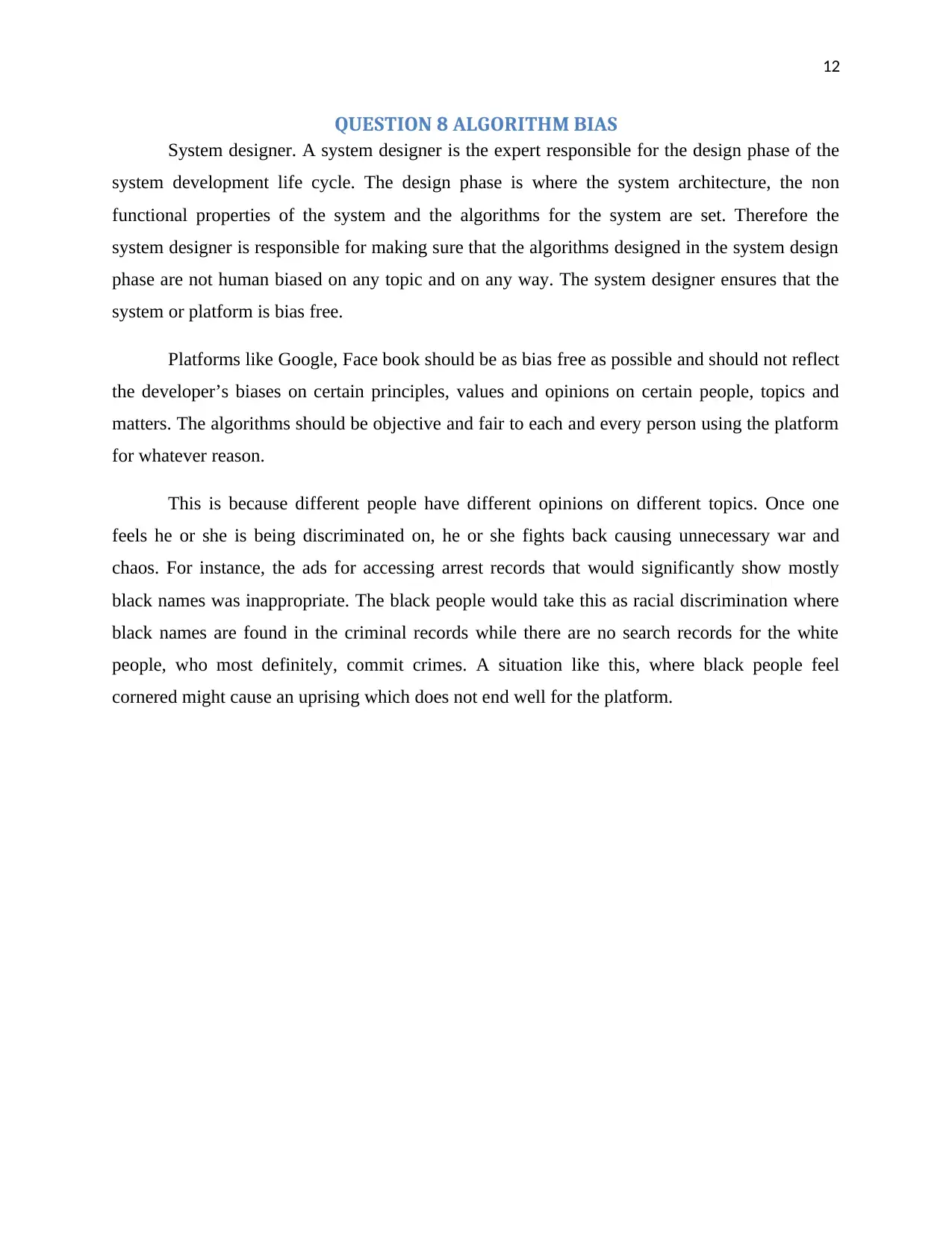
12
QUESTION 8 ALGORITHM BIAS
System designer. A system designer is the expert responsible for the design phase of the
system development life cycle. The design phase is where the system architecture, the non
functional properties of the system and the algorithms for the system are set. Therefore the
system designer is responsible for making sure that the algorithms designed in the system design
phase are not human biased on any topic and on any way. The system designer ensures that the
system or platform is bias free.
Platforms like Google, Face book should be as bias free as possible and should not reflect
the developer’s biases on certain principles, values and opinions on certain people, topics and
matters. The algorithms should be objective and fair to each and every person using the platform
for whatever reason.
This is because different people have different opinions on different topics. Once one
feels he or she is being discriminated on, he or she fights back causing unnecessary war and
chaos. For instance, the ads for accessing arrest records that would significantly show mostly
black names was inappropriate. The black people would take this as racial discrimination where
black names are found in the criminal records while there are no search records for the white
people, who most definitely, commit crimes. A situation like this, where black people feel
cornered might cause an uprising which does not end well for the platform.
QUESTION 8 ALGORITHM BIAS
System designer. A system designer is the expert responsible for the design phase of the
system development life cycle. The design phase is where the system architecture, the non
functional properties of the system and the algorithms for the system are set. Therefore the
system designer is responsible for making sure that the algorithms designed in the system design
phase are not human biased on any topic and on any way. The system designer ensures that the
system or platform is bias free.
Platforms like Google, Face book should be as bias free as possible and should not reflect
the developer’s biases on certain principles, values and opinions on certain people, topics and
matters. The algorithms should be objective and fair to each and every person using the platform
for whatever reason.
This is because different people have different opinions on different topics. Once one
feels he or she is being discriminated on, he or she fights back causing unnecessary war and
chaos. For instance, the ads for accessing arrest records that would significantly show mostly
black names was inappropriate. The black people would take this as racial discrimination where
black names are found in the criminal records while there are no search records for the white
people, who most definitely, commit crimes. A situation like this, where black people feel
cornered might cause an uprising which does not end well for the platform.
⊘ This is a preview!⊘
Do you want full access?
Subscribe today to unlock all pages.

Trusted by 1+ million students worldwide
1 out of 13
Related Documents
Your All-in-One AI-Powered Toolkit for Academic Success.
+13062052269
info@desklib.com
Available 24*7 on WhatsApp / Email
![[object Object]](/_next/static/media/star-bottom.7253800d.svg)
Unlock your academic potential
Copyright © 2020–2025 A2Z Services. All Rights Reserved. Developed and managed by ZUCOL.





